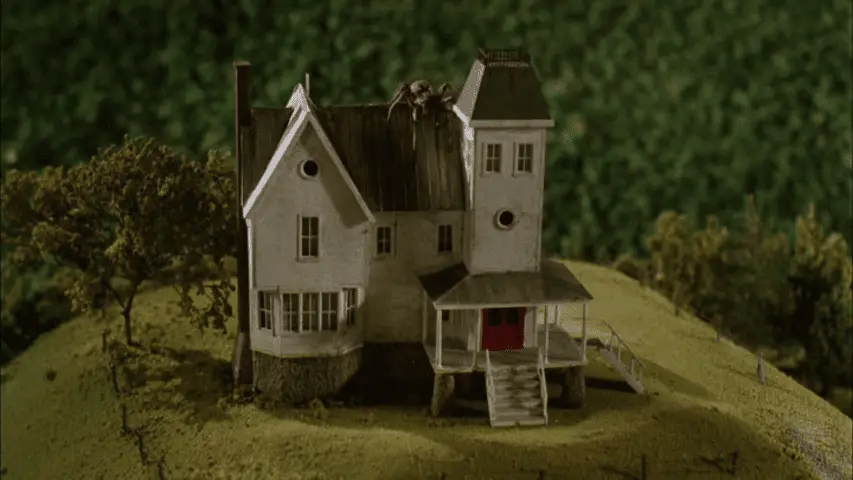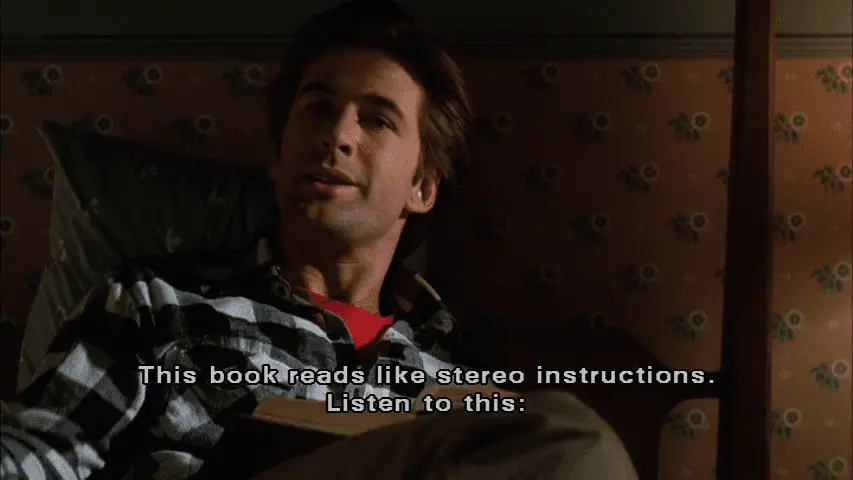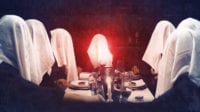Beetlejuice (1988) is a horror-comedy that endears itself to both horror fans and viewers who wouldn’t be caught deceased, recently or otherwise, watching a horror movie. What is it about this film that brings such disparate viewers together? It’s time to find out.

The Comedy
It’s clear from the chorus of “Day-o” that kicks off the film that Beetlejuice definitely has its decomposing finger on the “comedy” side of the horror-comedy scale…plus an eight-foot bunch of bananas.
Visually, the film opens with a sweeping shot guiding us through an entire small town until we reach the house that will be our own home for most of the film. The music helps this opening feel grand—but, visually, something’s off; the town looks just a little bit fake. A spider crawling over the final house leaves brief ambiguity about size (Is it a giant spider?) before Adam Maitland (Alec Baldwin) reaches out his hand and confirms that this is, in fact, a handmade model of the town.

Much of the comedy is, on the surface, straightforward: clever gags, funny voices (particularly from the title character), wordplay, slapstick, and more that wouldn’t be out of place in any other comedy.
Jane Butterfield (Annie McEnroe) popping up around the house trying to get Adam and Barbara Maitland (Geena Davis) to sell their home is a great example of Beetlejuice establishing its comedic tone early on. When Charles, Delia, and Lydia Deetz (Jeffrey Jones, Catherine O’Hara, and Winona Ryder) first move into the Maitland’s house and Otho (Glenn Shadix) drops in (through a window, no less), their obliviousness to the Maitlands’ attempts at horrifying displays is comedic because of the contrast; however, their non-reaction is because they cannot see the Maitlands. This means that, from their perspective, they’re merely acting how they would normally act, and the way they normally act is…eccentric, to say the least.
Even the music plays a role in the comedy. When Barbara points out the Handbook for the Recently Deceased to Adam, the orchestra hits ominous chords. He misreads the title as “Recently Diseased.” When she corrects him with “Deceased,” the orchestra hits more ominous chords. It’s a subtle gag, but it’s definitely one that got me laughing the very first time I watched the film.
By starting with the comedy, and when the horror elements are introduced, using the comedy as a “reaction” to it, it makes laughter a natural reaction to “the strange and unusual” for viewers, too.
But…with the audience trained to laugh at the lurid, where does the “horror” come in?
The Horror
The “horror” side of Beetlejuice is more in the subject matter than the execution (pun intended). Besides the horror movie elements of ghosts, haunted houses, and exorcism, Beetlejuice also uses real-life subjects such as implied fertility challenges, death (including implied parental death), mental health, suicide (including teen suicide), and forced marriage (specifically child marriage).

Watching later: …Wait…
Depicting exorcism as “death for the dead” is a fascinating and very dark topic: since this almost happens to Adam and Barbara, it’s taken relatively seriously (as seriously as this film takes anything); however, while it’s sad to watch this good-natured couple forcibly age until they begin to decompose in front of each other and everyone else, it doesn’t veer all the way into “horror” territory.
But why is this?
How They Mix
If you described the bare bones (pun intended) of certain scenes in Beetlejuice, they would sound like they came straight out of a horror movie.
For example: “A ghost trapped in the netherworld shows off his powers and just how scary he can be to try to convince two new ghosts into allowing him to wreak havoc on a family.”
In theory? Dark. In practice?
Possessing someone is a horrifying idea. But when the possessor uses that power to say it’s a trick that’s “fun at parties,” it becomes just that: a funny trick. A ghost’s head spinning while he screams? Freaky. But when it’s the latest in a rapid-fire stream of overtly comedic displays and is followed up with, “Don’tcha hate it when that happens?”, it becomes a funny curiosity.
In essence, the horror and comedy mix is achieved because the film takes its dark-in-theory premise and decides to have fun with it at every turn. The aforementioned early moment of Adam calmly coaxing the spider into his hand and releasing it outside through an open window sets the tone: a relatively large spider that may make some people scream is instead met with earnest fascination.
Now, how does one pinpoint why or how something is “fun”? Obviously, there are many ways. In Beetlejuice’s case, I can pin down a few significant factors.
Music, and sound in general, is extremely important in horror movies. The music throughout Beetlejuice is upbeat and, for lack of a better term, “lively,” and there are many comedic sound effects throughout.
As far as production design, there’s a lot of black, white, and gray, but there’s just as much of the film that’s very colorful, such as vivid greens and reds, lightening the tone. Though the film shows the aftermath of people who died in various, sometimes gruesome ways, the exaggerated way in which their mortal wounds are depicted, including bright colors, noticeable lack of blood in relation to what should be present, and the nonchalant attitudes of the deceased people in question, makes it more humorous than horrific.
Another important factor is how the characters react to what’s around them and what’s happening. For example, the aforementioned “deceased” who died in various ways and are very blasé about their respective conditions. If the woman who’s been chopped in half is simply reading the newspaper, then there’s no cause for alarm, and the contrast between the reaction and the situation adds to the comedy.
Despite the drab colors of Deetz’s house after Delia and Otho “fix it up,” the Deetzes go about their lives as if it’s a regular home and are not acting like they’re living in a haunted house.
Barbara and Adam Maitland drown and become ghosts, and yet, instead of grieving over lives unlived, they react to their mutual untimely demise with annoyance. Their frustration isn’t over friends and family they’ve left behind, what they could’ve done to avoid their demise or any “unfinished business,” but the fact that they can’t figure out how their new afterlife works.

Even when they decide to (or attempt to) haunt the Deetz family, their gentle nature not only prevents them from doing any real harm, but it also even makes living with ghosts look like fun. When I first saw Beetlejuice, my only knowledge of it was that I vaguely remembered enjoying reruns of the animated series, and I cannot overstate how surprising the famous “Banana Boat” scene is if you have absolutely no idea it’s coming. It’s so completely random and silly. Knowing that this is the Maitlands’ idea of something terrifying makes it even funnier and solidifies them as a complete non-threat. (Sorry, Barbara and Adam, we love you, but cold-blooded demons, you are not.)
Lydia is clearly going through some emotional turmoil, but when she encounters two ghosts in her house, her reaction isn’t fear, but fascination. She reads through the handbook that the Maitlands can’t get through. While she may not be overly fond of her stepmother, she genuinely wants everyone to get along.
And “the ghost with the most,” of course, is having the time of his afterlife.
This is supposed to be the “no holds barred, Beetlejuice is loose, look how unhinged he is!” climax. And yet, he’s speaking like a carnival barker and even using literal carnival games to do away with everyone. He’s like a fast-talking creepy comedian: a sleazy, spooky salesman.
There are many villains and monsters, both in horror and other genres, who have fun with the heinous acts they commit and come across as menacing. So why doesn’t Beetlejuice? It’s really a combination of all the aforementioned factors: the established comedic tone, the absence of actual gore, the bright and exaggerated visuals, the lively music, the reactions of the characters around him, the comedy in his dialogue, and Michael Keaton’s overall performance. Even ghosts that other ghosts fear become a little less threatening when they take a pause to hock a loogie into the inside of their jacket to “save that guy for later.”
In another example of horror-comedies showing something that more traditional horror movies don’t always get to show, check out Delia and Charles’ reactions in that scene. They’re clearly freaked out, but when Beetlejuice turns his focus to them, they attempt to cover it up with nervous smiles. Nervous smiles and laughter are actually very real responses to fear; however, many horror movies don’t show this, and understandably so. Done incorrectly, it could break the tension of a terrifying scene. Here, it adds further levity. Otho’s “moment in the spotlight” (pun intended) is the opposite of what we’ve previously seen in places like the Netherworld. Compared to being thrown down the stairs by a snake earlier in the film, his “torture” here is absolutely mundane. And yet, his reaction is extremely exaggerated mugging while wailing and fleeing.
Whether you love horror, hate horror, or want something fun for a group or to show kids, I recommend Beetlejuice. For horror fans who are accustomed to deadly serious (pun intended) films, it’s even funnier to see horror elements taken to such fun and comedic places. For non-horror fans (or kids who are either too young or not used to horror movies), it’s a great “spooky” movie that’s unlikely to induce any nightmares—although you’ll never look at shrimp the same way again.
Beetlejuice, both the character and the film, gets so many of us to laugh at death. Although the ghost with the most makes it look easy, that’s no small feat. So pop it in, find it on TV, or just say his name three times, and have some fun mocking mortality…and, if the “spirit” “moves” you (double pun intended), brush up on your calypso.



One Comment
Leave a Reply